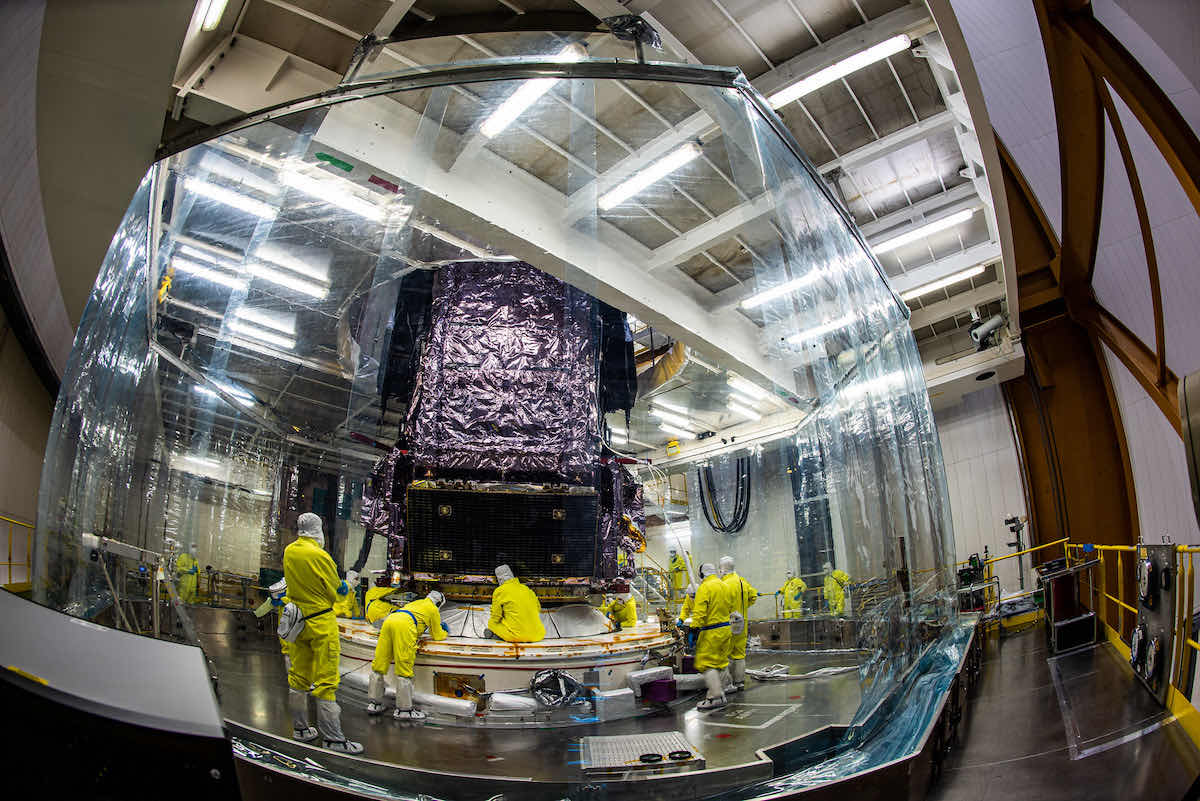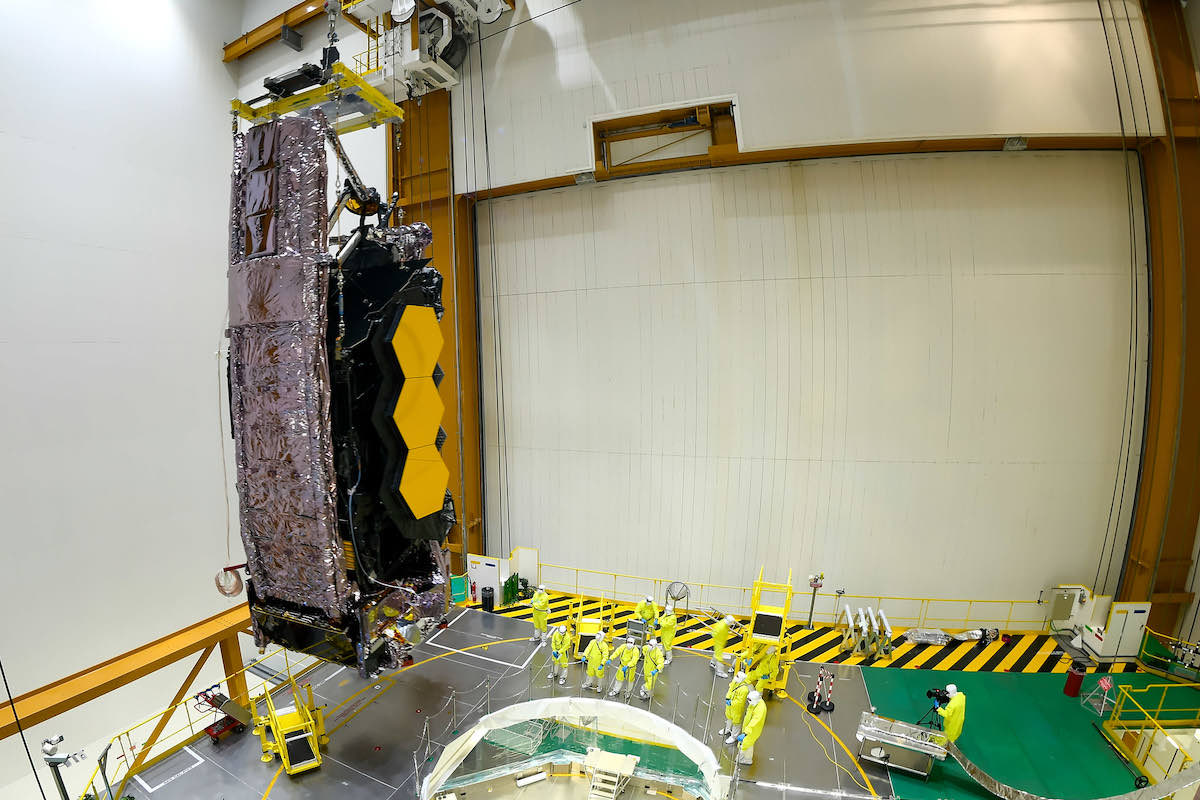
Engineers discovered an intermittent data dropout associated with a piece of ground support equipment after connecting the James Webb Space Telescope with its Ariane 5 launcher over the weekend in French Guiana. The observatory’s long-awaited blastoff will be delayed at least two days to Dec. 24 to troubleshoot the problem, the head of NASA’s science division said Tuesday.
The mission was previously set for takeoff Dec. 22 from the European-run Guiana Space Center in Kourou, French Guiana, on the northeastern coast of South America. A final step in preparation for Webb’s blastoff occurred Saturday, when the observatory was raised atop its Ariane 5 launch vehicle.
But a technical issue held up the next step in the launch campaign. The Ariane 5’s Swiss-made payload shroud was supposed to be lowered over the three-story-tall observatory Monday.
In a brief statement, NASA wrote on its website late Tuesday that the Webb team is “working a communications issue between the observatory and the launch vehicle system.”
Thomas Zurbuchen, associate administrator for NASA’s science mission directorate, said Tuesday that engineers found an “interface problem” in a system that communicates with Webb while it’s on top of the Ariane 5 rocket.
“The way to think about it is it’s a ground support equipment thing,” Zurbuchen said Tuesday night in an interview with Spaceflight Now. “Basically, the data cables are dropping some frames.”
Technicians inside the Ariane 5 rocket’s final assembly building in Kourou have tried to diagnose the problem, but so far, haven’t been able to resolve it.
“Tomorrow, we’re going up there with the ground support equipment, and just really making sure we can flush out where the issue is,” Zurbuchen said. “We’ve tried a bunch of things, and we just haven’t been successful. This is a 100-meter cable that goes all the way from the top of the rocket to somebody’s computer. Somewhere in there (is the problem), is our guess.
“But it’s too early to say,” he said. “We need to go after it tomorrow, and put some specific equipment into play … The way these things work, once you find it, it’s easy.”
Webb is a once-in-a-generation mission with a development cost of roughly $9.7 billion, making it the most expensive scientific spacecraft ever launched. Its foldable telescope will open to a span of more than 21 feet (6.5 meters) once in space, making Webb the largest space-based observatory in history.
The James Webb Space Telescope will ride the Ariane 5 on a half-hour ascent into space, beginning a journey to the observatory’s distant operating orbit near the L2 Lagrange point, a gravitationally-neutral location about four times farther from Earth than the moon.
After a series of crucial deployments of its sunshield and mirror array, Webb will begin peering deeper into the universe than any telescope before, probing the first galaxies and stars that formed after the Big Bang more than 13 billion years ago.

Ground teams encountered similar communications interface issues during preparations for recent launches of two smaller NASA missions, the DART asteroid deflection experiment and the IXPE X-ray astronomy mission, Zurbuchen said. Those missions were a bargain compared to Webb, with costs of $330 million and $214 million, respectively.
Those experiences show that technical glitches during launch processing are not unusual. Managers decided to go ahead with those launches, without incident.
“But if it’s Webb, we’re going to figure it out. We’re not gonna let anything stand. So for that reason, we can only encapsulate (Webb inside the payload fairing) Friday, and that basically moves the launch to no earlier than the 24th.”
Zurbuchen cautioned that the new Dec. 24 launch date is preliminary, but NASA wanted to announce the tentative new schedule before teams complete troubleshooting. NASA said it will provide more information about the Webb launch date no later than Friday.
“Many people have their holiday schedules related to what happens with Webb,” Zurbuchen said.
Officials hope to launch the Webb mission Dec. 24, but NASA and the European Space Agency have agreed to make a launch attempt for Webb on Christmas Day, if necessary, pending final agreement from CNES, the French space agency, according to Zurbuchen. CNES operates the launch range at the Guiana Space Center.
Thierry Wilmart, Arianespace’s mission director for the Webb launch, said last week the rocket teams could also attempt launch Dec. 25, if necessary. Arianespace is the French commercial launch services provider for Ariane 5 missions.
The Webb telescope has daily half-hour launch windows, all opening around 7:20 a.m. EST (1220 GMT; 9:20 a.m. Kourou time), through Jan. 6.
If the mission is still on the ground then, the launch would have to wait until around Jan. 13 to avoid the possibility of Webb passing too close to the moon on its way to the L2 Lagrange point nearly a million miles from Earth. Lunar gravity could bend the spacecraft’s trajectory, requiring it to burn more fuel on the journey.
Email the author.
Follow Stephen Clark on Twitter: @StephenClark1.
Article From & Read More ( NASA delays launch of Webb telescope to no earlier than Dec. 24 – Spaceflight Now - Spaceflight Now )https://ift.tt/3m63Dp6
Science
No comments:
Post a Comment